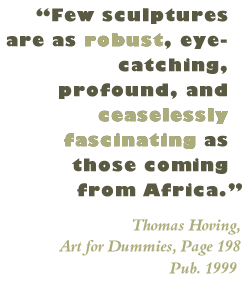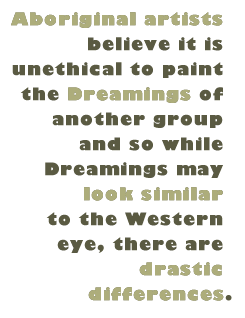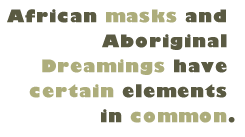Home-Art
329-GS 330-Lit 342-Hum
375-Com 385-GS 410-GS
450, Research-GS 450, Integration
|
|
|
Written by Jessica Albon |
|
|
|
 homas
Hoving's statement rings true specifically for the masks created in Africa, as testified
to by the tremendous number of websites and books devoted to the subject. The vibrancy
of African art is perhaps only paralleled by Aboriginal art. Aboriginal Dreamings have a
boldness of color quite unlike typical Western art. The similiarity of the art of both
Africa and Australia is compelling, and despite the distance between the two continents,
serves to connect them in the mind of the observer. homas
Hoving's statement rings true specifically for the masks created in Africa, as testified
to by the tremendous number of websites and books devoted to the subject. The vibrancy
of African art is perhaps only paralleled by Aboriginal art. Aboriginal Dreamings have a
boldness of color quite unlike typical Western art. The similiarity of the art of both
Africa and Australia is compelling, and despite the distance between the two continents,
serves to connect them in the mind of the observer.
However, such a topic as the allure of African and Aboriginal art is too broad and thus, for the purpose of this research paper, will be limited to a consideration of African masks and Aboriginal Dreamings. Of all the art we covered in this class, the art created by the Africans and the Aborigines holds the most mystery. Perhaps attributable to the drastic cultural differences between pre-colonial Africa and Australia, and the present-day U.S., this art seems to derive its power from its apparent complexity. Additionally, both African art and Aboriginal art have a system of highly complex and layered symbolism. This symbolism and its multiple interpretations is complicated. Finally, African masks and Aboriginal Dreamings both connect artist and ancestor though they perform this function in vastly different ways. In order to examine this topic coherently, this paper will begin by examining the characteristics of African masks and Aboriginal Dreamings. Second, this paper will address the purposes of African masks and Aboriginal Dreamings. Finally, this paper will consider elements of the symbolism of each, using examples to illustrate this symbolism. For the purpose of brevity and clarity, some generalizations will be made according to that which seems most common. Both Africa and Australia are substantial areas with considerably different traditions and artistic preferences among peoples. |
|
|
 frican masks are
often used in Masquerades. These masks enable the dancers wearing them to become
ancestral spirits, according to William Rea who writes, "it is often believed that
the person wearing the mask has been changed from an everyday man into a god or
spirit" (44). Paula Girshicle Ben-Gmos supports this assertion, writing, "the
mask wearers are usually called erinmwin, that is, representatives of the spirit
world" (76). frican masks are
often used in Masquerades. These masks enable the dancers wearing them to become
ancestral spirits, according to William Rea who writes, "it is often believed that
the person wearing the mask has been changed from an everyday man into a god or
spirit" (44). Paula Girshicle Ben-Gmos supports this assertion, writing, "the
mask wearers are usually called erinmwin, that is, representatives of the spirit
world" (76).
African masks are not created merely for human spectators. Instead, according to Frank Willett, they are often designed for those human spectators not to see specific elements. In some instances the features of a mask may be on top of it—too high for spectators to see—and in others, the features may be covered up. Frank Willett writes this is because masquerades are not merely performed for their human spectators, but also for the spirits (174-77). In fact, it is the ability of a mask to appeal to these spirit spectators that gives it part of its value. Additionally, masks may acquire value based on the social standing of the mask's owner. The owner t ransmits this value without necessarily affecting th e mask's appearance. Frank Willett writes, "the prestige of a mask is thus an acquired characteristic which cannot be deduced from its appearance" (180). Now that we have explored the way masks serve to bridge the spirit world with the physical world, we will consider the necessary characteristics of masks. First, a mask must serve its purpose. One of the ways a carver ensures a mask can serve its purpose is by constructing it to be comfortable to wear. The inside of the Dan mask on page 185 of Frank Willett's African Art displays the carver's attempts to ensure no rough edges remain inside the mask. Additio nally, masks must provide adequate visibility and ventilation for the wearer. All of these considerations provide the wearer with a mask that will be comfortable for the duration of the ritual. Should a mask be damaged, it is generally no longer considered effective "for they [masks] have to be beautiful in order to please the ancestors" (Willett, 184). Therefore, beauty is another of a mask's necessary characteristics. In terms of appearance, Yoruba sculpting standards largely apply. These standards include jijora, or resemblance to the subject; ifarahon, or differentiation of each element; didon, or sheen; gigun, or symmetry; odo, that is the subject must be young and vigorous; and tutu, or composure (Willett, 212-15). The Ibibio mask on page 201 of Willett's African Art (figure 195) displays these characteristics. It seems likely that it bears resemblance to a person (the features are not generic), the elements of the face are carefully constructed, it is luminescent, has symmetry, appears to be a healthy, young man, and the face lacks any overtures of anger. Even though this mask was not created by the Yoruba, it seems to adhere to the Yoruba standards. Thus, while some carvers do not strive for sheen, many of the characteristics remain the same regardless of artistic preferences. |
|
|
The Water Spirit mask provides a good example from which to draw conclusions based on African symbolism. This mask is worn by a woman during the female initiation ritual. This mask displays Mende ideals of feminine beauty. The forehead is broad and smooth to symbolize thoughtfulness and patience, the creased neck represents good health. The luminous skin signals youth, the well-shaped ears, and small mouth indicate the value placed on women who do not engage in gossip. The bird perched atop her head symbolizes "love, discipline, laughter, danger, and power" (Jones). These symbols have all been considered carefully and represent the ideal female in Mende society. Now that we have explored African masks, we will look at Aboriginal Dreamings. Like African masks, Aboriginal Dreamings serve as the bridge between ancestors and present-day people. Also similar, one clan's Dreaming is drastically different from any other clan's Dreaming, just as in Africa mask styles and rituals vary widely.
|
|
|
Aboriginal artists believe it is unethical to paint the Dreamings of another group and so while Dreamings may look similar to the Western eye, there are drastic differences. Thus the Dreamings on pages 55 (illustration 39) and 71 (illustration 55) of Wally Caruana's book may have some characteristics in common—e.g. the thick outlines and dots that fill in shapes—but they have completely different stories behind them. Don Gundinga's Honey Dreaming at Walkumbimirri overflows with animals, insects, humans, and spirits. Caruana further describes the painting's color (helpful, as the reproduction is in black and white) as, "The surface is highly animated with different coloured outlines, the bustling juxtaposition of images and the play of areas of cross-hatching which belie the images they decorate" (56). Mutitjpuy Mununggurr's Dugong hunt shows ancestral figures creating harpoons and paddles for the Dugong hunt. These figures too look as though they are likely brightly colored and vibrant, however, they depict the Dreaming of the Dugong. Interestingly, illustration 55 depicts the same Dreaming as illustration 56, with completely different effects. Instead of believing 55 and 56 were from the same people, it seems likely the average Western observer would pair illustrations 39 and 55 as being from the same people. The illustration on page 127 of Wally Caruana's Aboriginal Art show's Emu Dreaming, by Darby Jampijinpa Ross. In this painting, the Emu is represented by the footprints (see the symbol for Emu footprints). The spiraled lines, according to Caruana, represent intestines (129). The thick, straight, black lines symbolize "spears and digging sticks, symbolic of men and women respectively" (Ibid). It seems perhaps that these people are practicing agriculture (the date on the painting is 1987), or perhaps they are foraging. The symbols found in Dreamings are highly complex, and it seems likely that an observer would overlook important elements unless that observer had received special training. |
|
|
Differences also exist. Aboriginal Dreamings are painted, while masks are carved (though some masks are painted after being carved). Standards for evaluating Aboriginal Dreamings do not seem to exist, unlike standards for African masks. Dreamings seem further from Western understanding, perhaps because they are so large and can therefore hold so many more symbols. Additionally, Dreamings require the viewer to assimilate those symbols into a story, unlike African masks which seem more like props. Thus, there are both similarities and differences between the two arts. Regardless, both are non-traditional, interpretive examples of art beyond Western confines. See Works Consulted |

![Pull Quote: "the mask wearers [among the Benin] are usually called erinmwin, that is, representatives of the spirit world"](images/pullquotes/art329/art329gmos.gif)


